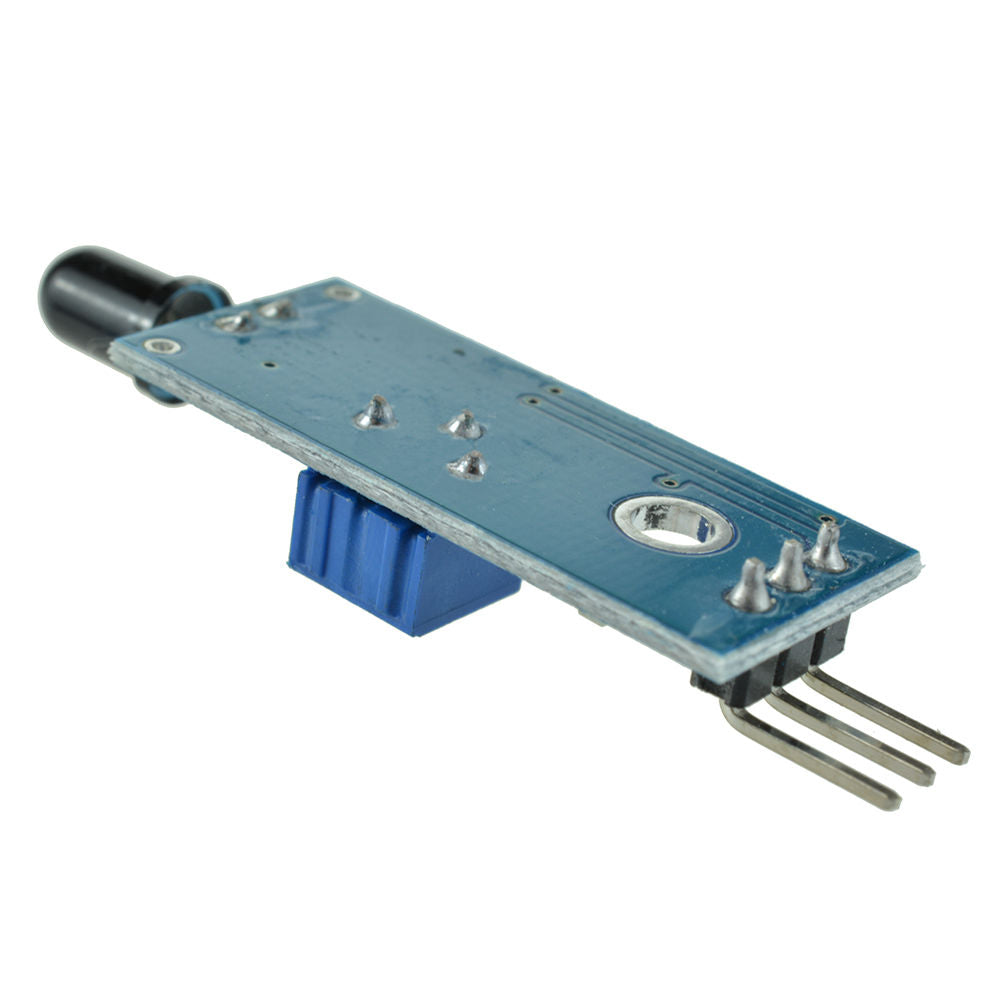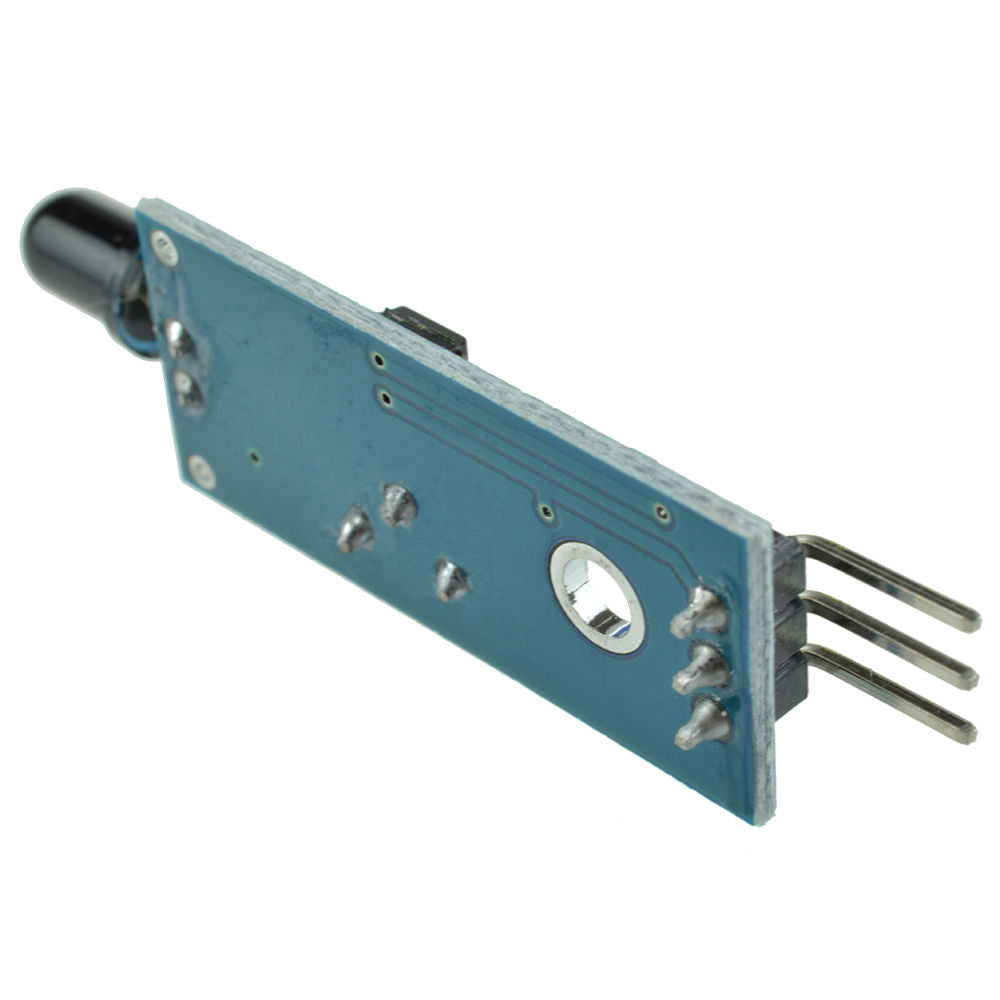




Description
The IR Flame Sensor Module for Arduino is a device that can detect flames by sensing infrared light emitted by them. It can be easily connected to an Arduino board and provides digital output for flame detection. The module has a sensitivity adjustment feature, allowing it to detect flames from different distances and intensities. Additionally, the module has a built-in comparator circuit that can be used to trigger another device when a flame is detected. The device is compact and lightweight, making it suitable for use in a variety of applications, including fire safety systems and robotics.
Package Includes:
- 1 x IR Flame Sensor Module
Features:
- Flame Detection: The module can detect the presence of flames or light sources in the 760 nm to 1100 nm wavelength range. The detection distance can reach up to 80cm and can detect larger flames at longer distances.
- Wide Detection Angle: The module has a detection angle of 60 degrees, making it highly sensitive to the flame spectrum.
- Adjustable Sensitivity: The module's sensitivity can be adjusted using the blue digital potentiometer to fine-tune the flame detection threshold.
- Clean Waveform: The comparator output signal has a clean waveform and a driving ability of over 15mA.
- Precision Potentiometer: The module has a precision potentiometer that allows for accurate sensitivity adjustments.
- Operating Voltage: The module can operate on a voltage range of 3.3V-5V.
- Output Modes: The module has two output modes, a digital switching output (DO) that can output 0 or 1 depending on the presence or absence of a flame,
- Easy Installation: The module has fixed bolt holes that make it easy to install in a variety of projects.
- Wide Voltage Comparator: The module uses a wide voltage LM393 comparator, making it suitable for a variety of voltage ranges and applications.
Description:
The IR Flame Sensor Module for Arduino is a highly versatile sensor that is perfect for detecting the presence of flames or light sources in the 760 nm to 1100 nm wavelength range. It has a detection distance of up to 80cm, and it can detect larger flames at greater distances due to its highly sensitive 60-degree detection angle. The module's sensitivity can be adjusted using the blue digital potentiometer, allowing for precise calibration of the flame detection threshold. The comparator output signal has a clean waveform, and it has a driving ability of over 15mA. Additionally, the module has a precision potentiometer that enables accurate sensitivity adjustments. The IR Flame Sensor Module can operate on a voltage range of 3.3V-5V, making it highly versatile and compatible with a wide range of projects. It has two output modes, including a digital switching output (DO) that outputs 0 or 1 depending on the presence or absence of a flame. Installation of the module is easy, thanks to the fixed bolt holes that make it easy to install in a variety of projects. The PCB size of the module is small, measuring just 3.2cm x 1.4cm, making it perfect for compact projects. The module uses a wide voltage LM393 comparator, making it suitable for a variety of voltage ranges and applications.
Principle of Work:
The IR Flame Sensor Module for Arduino works by detecting the infrared light emitted by flames. The module contains an infrared receiver that is sensitive to the specific wavelengths of light emitted by flames. When a flame is present, it emits infrared light that is detected by the receiver in the module. The infrared receiver then converts the detected light into an electrical signal, which is then processed by the module's built-in comparator circuit. The comparator circuit compares the electrical signal to a set threshold, which can be adjusted using the potentiometer on the board. If the electrical signal exceeds the threshold, the comparator circuit triggers the digital output pin (D0) to go high, indicating the presence of a flame. If the electrical signal is below the threshold, the output pin remains low. The sensitivity adjustment feature allows the user to fine-tune the threshold for flame detection, making the module suitable for detecting flames at different intensities and distances.
Pinout of the Module:

- VCC - This is the power supply pin and should be connected to the 5V pin of the Arduino board or any other power source that provides a voltage within the module's operating range (typically 3.3V - 5V).
- GND - This is the ground pin and should be connected to the ground pin of the Arduino board or any other ground connection.
- D0 - This is the digital output pin and is used to detect the presence of a flame. When a flame is detected, the D0 pin will output a high signal (typically 3.3V - 5V), otherwise, it will output a low signal (0V).
Applications:
- Fire detection systems: The module can be used in fire detection systems to quickly and accurately detect the presence of flames, allowing for early warning and prevention of fires.
- Industrial automation: The module can be used in industrial automation systems to detect flames in machinery, ensuring safe and reliable operation.
- Robotics: The module can be used in robotics applications to detect flames or light sources and enable the robot to react appropriately.
- Security systems: The module can be used in security systems to detect flames or light sources and trigger alarms or other responses.
- Home automation: The module can be used in home automation systems to detect flames or light sources and trigger automated responses, such as turning off appliances or turning on sprinkler systems.
- Environmental monitoring: The module can be used in environmental monitoring systems to detect wildfires or other natural disasters, enabling early response and mitigation.
Circuit:
Alarm sound with a buzzer when the flame module detects a flame:

-
IR Flame Sensor Module:
- VCC pin to Arduino 5V pin
- GND pin to Arduino GND pin
- D0 pin to Arduino digital pin 2
-
Buzzer:
- Positive pin to Arduino digital pin 11
- Negative pin to Arduino GND pin
Library:
No library Needed
Code:
A code for the IR Flame Sensor Module connected to an Arduino Uno on digital pin 2 and a ceramic wafer buzzer connected to pin 11 as a speaker. The code will sound an alarm on the buzzer and print the status to the serial monitor when the flame module detects a flame.
// IR Flame Sensor Module with Buzzer
int flamePin = 2; // IR Flame Sensor Module connected to digital pin 2
int buzzerPin = 11; // Ceramic Wafer Buzzer connected to digital pin 11
void setup() {
pinMode(flamePin, INPUT); // Set flamePin as input
pinMode(buzzerPin, OUTPUT); // Set buzzerPin as output
Serial.begin(9600); // Start the serial communication
}
void loop() {
int flameValue = digitalRead(flamePin); // Read the flame sensor module value
if(flameValue == HIGH) { // If flame is detected
Serial.println("Flame Detected!"); // Print status to the serial monitor
digitalWrite(buzzerPin, HIGH); // Turn on the buzzer
delay(500); // Wait for 500ms
digitalWrite(buzzerPin, LOW); // Turn off the buzzer
delay(500); // Wait for 500ms
}
}
Technical Specifications:
- Detection range: 760 nm to 1100 nm wavelength
- Detection distance: up to 80cm
- Detection angle: 60 degrees
- Sensitivity adjustment: via a blue digital potentiometer
- Comparator output: a clean waveform with driving ability > 15mA
- Operating voltage: 3.3V to 5V
- Output modes: digital switching output (DO).
- PCB size: 3.2cm x 1.4cm
- Comparator: LM393 wide voltage comparator





